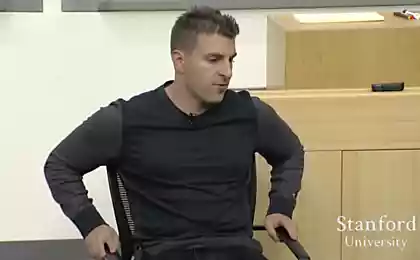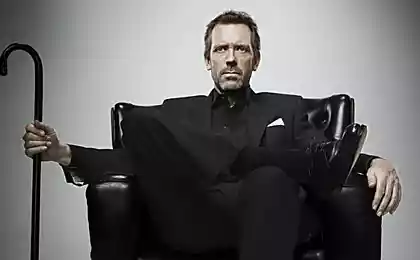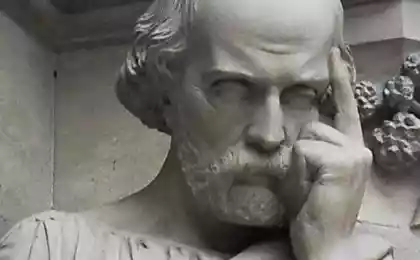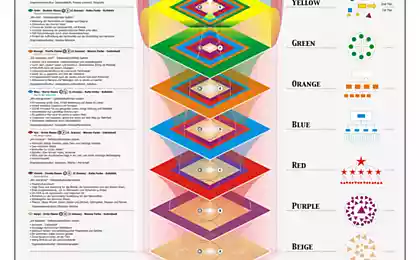550
WHAT is the disease with the position of the neurological levels
Sometimes the doctor fails to significantly change the condition of the patient. Strange, because we know so much about the disease... the Solution, often, is at the intersection with other knowledge. It is proposed here to consider the disease from a position neurological (logical) levels.
The notion of logical levels refers to the fact that some processes and phenomena can be the result of relations between other processes and phenomena.
The term "logical levels" in the sense in which it is used in NLP, was adapted by Robert Dilts from work by Gregory Bateson. Gregory Bateson was inspired by the mathematical theory of logical types, Bertrand Russell, who postulated that the object class cannot be a member of itself.
The logic levels are a hierarchy of levels of processes occurring in an individual or in a group. The function of each level is the synthesis, organization and management of interactions at a lower level.

LOGICAL LEVELS (DILTS)
Environment
What makes the environment in the disease of the DOE? His family, his job, his apartment, city, country. What is the role of the family in the development or reinforcement of his illness? what do you think headache to the average person and headache in a person who care for cancer patients is one and the same? Do you think my lecturer and my artist is one and the same? Pain in the back of the fighter and back pain the Director of the plant? The work of a judge and a housewife is there a difference? Complete or incomplete family. The atmosphere of the house, the atmosphere at work. It's not so much the fact, as in accordance of fact ideas.
What is the situation at home? What a person receives as aggression, rejection, constant reproaches? It tugged at a feeling of duty? And how he receives love, care, and "strokes"? This is true for women and man and child and lady.
Behavior
The disease can be considered as a behavioral violation, or more gently – behavioral adaptation. That is, the disease is not only feeling (pain, limitation of range of motion, the change in the vital parameters), but different behavior. Most simply, the meaning of illness described by Carl and Stephanie Simonton
5 meanings of illness by Simonton
1. The disease gives to escape from unpleasant situations or solve complex problems.
2. The disease provides an opportunity to care, love, attention.
3. The disease gives conditions in order to refocus necessary to resolve problems or mental energy to revise his understanding of the situation.
4. The disease provides an incentive to revalue themselves as individuals or of changes in habitual behavior.
5. The disease takes away the need to meet the high demands of others and himself to himself.
Here, usually, the patients being difficult and say that their disease makes no sense that it is pointless and brings only misery. Such a statement-type charges of nature in the mistake. If to remove value judgments and linear look at how has changed the behavior of the person with the disease, then there is a way to change the behavior properly, but without the illness instead of or to her.
Ability
Of healing, energy, motivation. If the patient's ability to heal? Does he have the energy? Does he have the motivation?
If the patient has no ability, energy healing, applying to it the technique he does energy to end – it may get worse, can break the latest adaptation mechanisms. Therefore, it is necessary to understand whether there is energy, and if not, then at first to work only with energy, not "curing".
You can break the wall of demotivation. Remember the joke-parable about suicide with obesity?
(He didn't fit in the electric chair, and it was decided to delay the execution for a few months before his weight loss. A few months later he still had not got in the electric chair, because it is not lost. "There is no motivation...").
Where it is necessary to look difficulty with motivation? In environment, behavior, beliefs and so on, that is all. If not, therapeutic the chances tend to zero.
Beliefs/values
Beliefs of resource "I was sick and need it as soon as possible to cure" "What to do?" "How?". In the paradigm of healing medical tool. The basic idea is that the disease is in principle cured. How is not important. Who forms beliefs – authority, or accidentally, at the level of suggestion. What do we do with the resource beliefs? Rocking even more, and if not, then formed.
Nerealnye beliefs
Basic word-level values of "chronic". From the same series, the words "infertility", "tumor", "dysplasia" and so on. Compare the phrase "I have two days sore lower back" and "I have a herniated disc". The main contribution to the formation of presurned beliefs made by doctors, parents and the media. So be careful with prisurskii beliefs, which are usually installed by uncontrolled compulsion. Established pressuree belief, usually, is on values and beliefs, and that is bad change, requires psychotherapy, and psychotherapy do not go, as values and beliefs is the core of the I, "I my I" and to change that is not desirable.
Values
If health is not a value, then it will not. "It is important to educate children", "I have to work" — faced with such claims? And how do you "you are a doctor, you know better". Another situation – a conflict of values. Health value, but it conflicts with others: work, family, and public opinion. "I'm a fool to walk with ski poles in the city," or "I'll go to the gym, I don't know anyone there" or "not going to trenazherku, I'm fat". The conflict of values "health" and "image".
Identity
Identity – who he thinks the patient is healthy or sick. The main pair here is "I'm healthy – I'm sick." As age identification, "I'm old", or "will get to be my age..." Identity limits the choice determines the behavior. Connected with the archetypes, avatars from movies, literature and life – how to look sick and healthy people. It can also be used in the visualization of recovery as the goal.

Imaging requirements
Big picture, the size of a movie screen. The third person is used in the series: the villain got the gun and went to the credits, then you wait for the next series. Picture desirable, bright, colourful, three-dimensional, above the level of horizon – all this is used in advertising, something in the churches (icons, frescoes, painted at the top). Where are the cigarettes in stores? The visualization should be archetypal – definitely clear, symbolic — I'm running in the stadium is "I am Healthy", and lying with a bubble of ice on the head and a drip is "a healthy Me". When to visualize? It is best before going to sleep in the cracks between reality and dream when the brain produces alpha waves, and even more below.
Nerealnye identity, or weakness
Eric Berne described among other the game of "Wooden leg", described by the slogan "what you want me to do with a wooden leg", for example "what do you want from me – I have angina", or "I'm not allowed in the pool – I have a sinus infection" and so on. "I – hypertensive" is an example of the identity of the patient. This is in line with the abilities power to change. Often doctors are investing in the formation of naresources identity, putting the diagnosis is syndromal. It emerged not so long ago.
In 80hh years normal was descriptive, nick non-binding, the diagnosis of "lumbalgia", "lumbago", "sciatica". Now, such diagnoses are not put, put morphological diagnosis, such as "herniated disc L5-S1, L5 analyses, anatomical narrowing of the channel", that is tied to the feelings of the patient to the picture on the CT - MRI, although the sensation may be caused by other processes occurring in the patient. Doctors think like this: "today, I have had 2 of the 3 cholecystitis and pancreatitis". Where is the patient?
The resource identity, or power
"I am healthy, but now he was sick or injured" — that's the resource identity. If such an identity, then all is well, the chances of recovery are great. If you don't? If detected precursory identity, or weakness? In the forehead it's hard to change identity, even impossible. It is necessary to gradually blur it with the blur level of belief. Well, when beliefs are demonstrably false – do not understand people article on the Internet or in the textbook, and this built his identity. Realized, for example, that it Chronicles, and in fact confused the names of diseases, and it is easy to destroy, to tell him that the disease to be treated, accordingly it is not forever patient, and temporarily, that is, he is healthy, but temporarily sick.
Mission/spiritual level
If you are an atheist, this question is for you or no longer, or it can be viewed from the scientific standpoint of biological communication, field theory, mirror neurons, genetic determinants and various other theories, the essence of one – man lives in a vacuum, it is connected with the outside world, is associated with his birth and his life filled with meaning.
Natsioalnymi level
The level of consideration "Mission" is natsioalnymi level. The disease can be considered at the subcellular, cellular, tissue, organ, system level, at the level of the whole person with his mentality at the social level it was in the Behavior section, or example: post-partum symphysis can only be the mother, childhood diseases in children, from the elderly to their illness.
The social factor must be considered: the 6 year old may not be complaints of erectile dysfunction, but the 26-year-old can treat chlamydia 26 year young lady, but do not treat in 66 years. People can tell all about your tonsillitis, but not the gonorrhoea, if it's not the soldiers, for whom to be ill with gonorrhea do not condemn, but even Vice versa. Natsioalnymi level is the mission level, or spiritual level. Usually it is for severe diseases.
Low back pain — the price paid for not understanding their own body
Why Zelenka is not used anywhere in the world, except CIS?
Why or why?
We used to discuss the disease as a response to the question, "Why? Why?", that is, to seek the cause of disease in the past, and have the opportunity to answer the question, "Why? For what?" that is to look for the cause in the future. In other cases, it does not seem so strange.
For example, we can evaluate exactly – no amount of primer and zinc white spent on it, and the message that conveys the artist through the painting. Or we recognize that the house was not built due to the fact that there were bricks, cement, sand, and the use of these elements, again implementing the idea of the architect. published
Author: Arseny Gorichev
Source: vk.com/medalternativainfo?w=wall-94239677_4317
The notion of logical levels refers to the fact that some processes and phenomena can be the result of relations between other processes and phenomena.
The term "logical levels" in the sense in which it is used in NLP, was adapted by Robert Dilts from work by Gregory Bateson. Gregory Bateson was inspired by the mathematical theory of logical types, Bertrand Russell, who postulated that the object class cannot be a member of itself.
The logic levels are a hierarchy of levels of processes occurring in an individual or in a group. The function of each level is the synthesis, organization and management of interactions at a lower level.

LOGICAL LEVELS (DILTS)
- Mission
- Identity
- Beliefs
- Ability
- Behavior
- Environment
Environment
What makes the environment in the disease of the DOE? His family, his job, his apartment, city, country. What is the role of the family in the development or reinforcement of his illness? what do you think headache to the average person and headache in a person who care for cancer patients is one and the same? Do you think my lecturer and my artist is one and the same? Pain in the back of the fighter and back pain the Director of the plant? The work of a judge and a housewife is there a difference? Complete or incomplete family. The atmosphere of the house, the atmosphere at work. It's not so much the fact, as in accordance of fact ideas.
What is the situation at home? What a person receives as aggression, rejection, constant reproaches? It tugged at a feeling of duty? And how he receives love, care, and "strokes"? This is true for women and man and child and lady.
Behavior
The disease can be considered as a behavioral violation, or more gently – behavioral adaptation. That is, the disease is not only feeling (pain, limitation of range of motion, the change in the vital parameters), but different behavior. Most simply, the meaning of illness described by Carl and Stephanie Simonton
5 meanings of illness by Simonton
1. The disease gives to escape from unpleasant situations or solve complex problems.
2. The disease provides an opportunity to care, love, attention.
3. The disease gives conditions in order to refocus necessary to resolve problems or mental energy to revise his understanding of the situation.
4. The disease provides an incentive to revalue themselves as individuals or of changes in habitual behavior.
5. The disease takes away the need to meet the high demands of others and himself to himself.
Here, usually, the patients being difficult and say that their disease makes no sense that it is pointless and brings only misery. Such a statement-type charges of nature in the mistake. If to remove value judgments and linear look at how has changed the behavior of the person with the disease, then there is a way to change the behavior properly, but without the illness instead of or to her.
Ability
Of healing, energy, motivation. If the patient's ability to heal? Does he have the energy? Does he have the motivation?
If the patient has no ability, energy healing, applying to it the technique he does energy to end – it may get worse, can break the latest adaptation mechanisms. Therefore, it is necessary to understand whether there is energy, and if not, then at first to work only with energy, not "curing".
You can break the wall of demotivation. Remember the joke-parable about suicide with obesity?
(He didn't fit in the electric chair, and it was decided to delay the execution for a few months before his weight loss. A few months later he still had not got in the electric chair, because it is not lost. "There is no motivation...").
Where it is necessary to look difficulty with motivation? In environment, behavior, beliefs and so on, that is all. If not, therapeutic the chances tend to zero.
Beliefs/values
Beliefs of resource "I was sick and need it as soon as possible to cure" "What to do?" "How?". In the paradigm of healing medical tool. The basic idea is that the disease is in principle cured. How is not important. Who forms beliefs – authority, or accidentally, at the level of suggestion. What do we do with the resource beliefs? Rocking even more, and if not, then formed.
Nerealnye beliefs
Basic word-level values of "chronic". From the same series, the words "infertility", "tumor", "dysplasia" and so on. Compare the phrase "I have two days sore lower back" and "I have a herniated disc". The main contribution to the formation of presurned beliefs made by doctors, parents and the media. So be careful with prisurskii beliefs, which are usually installed by uncontrolled compulsion. Established pressuree belief, usually, is on values and beliefs, and that is bad change, requires psychotherapy, and psychotherapy do not go, as values and beliefs is the core of the I, "I my I" and to change that is not desirable.
Values
If health is not a value, then it will not. "It is important to educate children", "I have to work" — faced with such claims? And how do you "you are a doctor, you know better". Another situation – a conflict of values. Health value, but it conflicts with others: work, family, and public opinion. "I'm a fool to walk with ski poles in the city," or "I'll go to the gym, I don't know anyone there" or "not going to trenazherku, I'm fat". The conflict of values "health" and "image".
Identity
Identity – who he thinks the patient is healthy or sick. The main pair here is "I'm healthy – I'm sick." As age identification, "I'm old", or "will get to be my age..." Identity limits the choice determines the behavior. Connected with the archetypes, avatars from movies, literature and life – how to look sick and healthy people. It can also be used in the visualization of recovery as the goal.

Imaging requirements
Big picture, the size of a movie screen. The third person is used in the series: the villain got the gun and went to the credits, then you wait for the next series. Picture desirable, bright, colourful, three-dimensional, above the level of horizon – all this is used in advertising, something in the churches (icons, frescoes, painted at the top). Where are the cigarettes in stores? The visualization should be archetypal – definitely clear, symbolic — I'm running in the stadium is "I am Healthy", and lying with a bubble of ice on the head and a drip is "a healthy Me". When to visualize? It is best before going to sleep in the cracks between reality and dream when the brain produces alpha waves, and even more below.
Nerealnye identity, or weakness
Eric Berne described among other the game of "Wooden leg", described by the slogan "what you want me to do with a wooden leg", for example "what do you want from me – I have angina", or "I'm not allowed in the pool – I have a sinus infection" and so on. "I – hypertensive" is an example of the identity of the patient. This is in line with the abilities power to change. Often doctors are investing in the formation of naresources identity, putting the diagnosis is syndromal. It emerged not so long ago.
In 80hh years normal was descriptive, nick non-binding, the diagnosis of "lumbalgia", "lumbago", "sciatica". Now, such diagnoses are not put, put morphological diagnosis, such as "herniated disc L5-S1, L5 analyses, anatomical narrowing of the channel", that is tied to the feelings of the patient to the picture on the CT - MRI, although the sensation may be caused by other processes occurring in the patient. Doctors think like this: "today, I have had 2 of the 3 cholecystitis and pancreatitis". Where is the patient?
The resource identity, or power
"I am healthy, but now he was sick or injured" — that's the resource identity. If such an identity, then all is well, the chances of recovery are great. If you don't? If detected precursory identity, or weakness? In the forehead it's hard to change identity, even impossible. It is necessary to gradually blur it with the blur level of belief. Well, when beliefs are demonstrably false – do not understand people article on the Internet or in the textbook, and this built his identity. Realized, for example, that it Chronicles, and in fact confused the names of diseases, and it is easy to destroy, to tell him that the disease to be treated, accordingly it is not forever patient, and temporarily, that is, he is healthy, but temporarily sick.
Mission/spiritual level
If you are an atheist, this question is for you or no longer, or it can be viewed from the scientific standpoint of biological communication, field theory, mirror neurons, genetic determinants and various other theories, the essence of one – man lives in a vacuum, it is connected with the outside world, is associated with his birth and his life filled with meaning.
Natsioalnymi level
The level of consideration "Mission" is natsioalnymi level. The disease can be considered at the subcellular, cellular, tissue, organ, system level, at the level of the whole person with his mentality at the social level it was in the Behavior section, or example: post-partum symphysis can only be the mother, childhood diseases in children, from the elderly to their illness.
The social factor must be considered: the 6 year old may not be complaints of erectile dysfunction, but the 26-year-old can treat chlamydia 26 year young lady, but do not treat in 66 years. People can tell all about your tonsillitis, but not the gonorrhoea, if it's not the soldiers, for whom to be ill with gonorrhea do not condemn, but even Vice versa. Natsioalnymi level is the mission level, or spiritual level. Usually it is for severe diseases.
Low back pain — the price paid for not understanding their own body
Why Zelenka is not used anywhere in the world, except CIS?
Why or why?
We used to discuss the disease as a response to the question, "Why? Why?", that is, to seek the cause of disease in the past, and have the opportunity to answer the question, "Why? For what?" that is to look for the cause in the future. In other cases, it does not seem so strange.
For example, we can evaluate exactly – no amount of primer and zinc white spent on it, and the message that conveys the artist through the painting. Or we recognize that the house was not built due to the fact that there were bricks, cement, sand, and the use of these elements, again implementing the idea of the architect. published
Author: Arseny Gorichev
Source: vk.com/medalternativainfo?w=wall-94239677_4317























